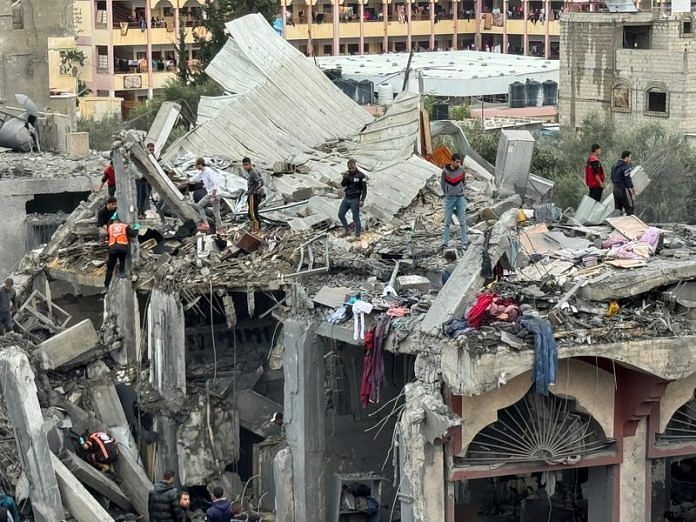(Reuters) – Israel and Hamas have agreed to a ceasefire in Gaza for at least four days, to let in aid and release at least 50 hostages captured by militants in exchange for at least 150 Palestinians jailed in Israel.
The following is a timeline of the war between Israel and Hamas, the Islamist movement which controls the Gaza Strip.
Oct. 7: Hamas gunmen launch a surprise attack on southern Israel, crossing over from Gaza and rampaging through towns. Israel says the gunmen kill 1,200 people, mainly civilians, and take more than 240 hostages.
Hamas military commander Mohammad Deif announces on Hamas media that the attack has started and urges Palestinians everywhere to fight.
Israeli Prime Minister Benjamin Netanyahu says Israel is “at war” and retaliatory air strikes against Hamas-run Gaza begin, along with a total siege of the narrow coastal enclave squeezed between Israel and Egypt.
Oct. 13: Israel tells residents of Gaza City, where more than 1 million of the enclave’s 2.3 million people live, to evacuate and move south. Gaza remains closed and residents say they have nowhere to go after southern parts of the Strip are bombarded.
Oct. 17: An explosion at al-Ahli al-Arabi Baptist hospital in Gaza City causes heavy casualties and triggers outrage in the Arab world. Palestinians blame the blast on an Israeli air strike but Israel says it was caused by a misfiring Palestinian rocket launch.
The health ministry in Gaza says 471 people were killed. Israel disputes this figure and an unclassified U.S. intelligence report estimates the death toll “at the low end of the 100 to 300 spectrum”.
Oct. 18: U.S. President Joe Biden visits the Middle East to show support for Israel and prevent a wider regional conflict. He ascribes the hospital blast to an errant rocket fired by Gaza militants. Arab leaders respond to the deaths at the hospital, which they blame on Israel, by cancelling a summit with Biden in Jordan.
Oct. 20: Hamas releases two American hostages – Judith Tai Raanan, 59, and her daughter Natalie, 17. The women were taken from Nahal Oz kibbutz in southern Israel.
Oct. 21: Aid trucks are allowed through the Rafah border crossing from Egypt into Gaza after days of diplomatic wrangling. It is only a small fraction of what is required in Gaza, where food, water, medicines and fuel are running out.
Oct. 23: Hamas releases two more hostages, elderly Israelis Nurit Cooper and Yocheved Lifshitz, “on humanitarian and poor health grounds”. The two women were kidnapped from Nir Oz kibbutz in southern Israel with their husbands, who are still held by Hamas. As she is freed, Lifshitz shakes hands with one of the militants and says “shalom” (peace).
Oct. 26: Israeli forces carry out their biggest raid into Gaza so far, with tanks and infantry hitting infrastructure and anti-tank missile launch posts.
Oct. 27: Israel’s chief military spokesman says Israeli ground forces are expanding their operations inside Gaza, signalling the start of a ground offensive.
Oct. 28: Netanyahu says Israeli forces have begun the second phase of the war and says Israel will “destroy the enemy above ground and below ground.” He tells Israelis to expect a “long and hard” military campaign.
Oct. 31: Israeli air strikes hit Gaza’s densely populated Jabalia refugee camp. Israel says it has killed a Hamas commander. Palestinian health officials say the strike killed about 50 people and wounded 150.
Nov. 1: Evacuations from Gaza begin through the Rafah crossing for an estimated 7,000 foreign passport holders, dual nationals and their dependents, and people needing urgent medical treatment.
Nov. 6: U.N. Secretary General Antonio Guterres says Gaza is becoming a “graveyard for children”, and demands a ceasefire. Palestinian health authorities say the death toll from Israeli strikes has exceeded 10,000.
Nov. 13: Israeli tanks advance on Gaza City’s Al Shifa hospital, with some 650 patients still inside. Israel says the hospital sits atop tunnels housing a headquarters for Hamas fighters using patients as shields, which Hamas denies.
Nov. 15: Israeli special forces enter Al Shifa Hospital and search the site, which covers more than 20 acres, with patients still inside. They initially uncover only a small collection of weapons but in the following days find the entrance to a concrete-walled tunnel and show footage of what they say is a 55-metre section, 10 metres underground.
Charges of war crimes are exchanged on both sides, with Palestinians accusing Israel of targeting civilians and Israel saying militant groups use civilians as human shields.
Nov. 21: Israel and Hamas announce agreement on a four-day pause in fighting. Netanyahu’s office says 50 women and children will be released and that the pause will be extended by another day for every additional 10 hostages released.
Hamas says the 50 hostages will be released in exchange for 150 Palestinian women and children detainees in Israel, and that humanitarian, medical and fuel aid will be allowed into Gaza.
Gaza’s Hamas-run government says at least 13,300 Palestinians have been confirmed killed, including at least 5,600 children, in the Israeli bombardment.
(Compiled by Alexandra Hudson, Editing by James Mackenzie and Timothy Heritage)
Disclaimer: This report is auto generated from the Reuters news service. ThePrint holds no responsibilty for its content.



